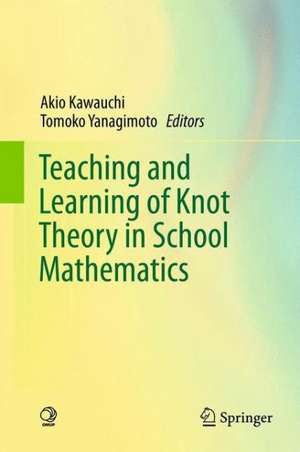Teaching and Learning of Knot Theory in School Mathematics
Editat de Akio Kawauchi, Tomoko Yanagimotoen Limba Engleză Hardback – 27 iun 2012
| Toate formatele și edițiile | Preț | Express |
|---|---|---|
| Paperback (1) | 358.09 lei 38-44 zile | |
| Springer – 23 aug 2016 | 358.09 lei 38-44 zile | |
| Hardback (1) | 392.60 lei 43-57 zile | |
| Springer – 27 iun 2012 | 392.60 lei 43-57 zile |
Preț: 392.60 lei
Nou
Puncte Express: 589
Preț estimativ în valută:
75.15€ • 81.65$ • 63.16£
75.15€ • 81.65$ • 63.16£
Carte tipărită la comandă
Livrare economică 21 aprilie-05 mai
Preluare comenzi: 021 569.72.76
Specificații
ISBN-13: 9784431541370
ISBN-10: 4431541373
Pagini: 204
Ilustrații: XIV, 188 p.
Dimensiuni: 155 x 235 x 17 mm
Greutate: 0.52 kg
Ediția:2012
Editura: Springer
Colecția Springer
Locul publicării:Tokyo, Japan
ISBN-10: 4431541373
Pagini: 204
Ilustrații: XIV, 188 p.
Dimensiuni: 155 x 235 x 17 mm
Greutate: 0.52 kg
Ediția:2012
Editura: Springer
Colecția Springer
Locul publicării:Tokyo, Japan
Public țintă
ResearchCuprins
1. What is Knot Theory?---Why Is It in Mathematics?2. The Evolution of Mathematics Education---forwarding the research and practice of teaching knot theory in mathematics education---3. The Background of Developing Teaching Contents of Knot Theory 4. Education Practice in Elementary School 5. Education Practices in Junior High School 6. Education Practices in Senior High School 7. Education Practice at the University as Liberal Arts and Teacher Education-Index
Recenzii
From the reviews:
“The book is about knot theory in the Japanese school system. It contains seven chapters which map the different viewpoints on the subject. … the book might be interesting for someone with a detailed interest in the situation of the teaching of knot theory in schools in Japan.” (Stephan Rosebrock, Zentralblatt MATH, Vol. 1257, 2013)
“The book is about knot theory in the Japanese school system. It contains seven chapters which map the different viewpoints on the subject. … the book might be interesting for someone with a detailed interest in the situation of the teaching of knot theory in schools in Japan.” (Stephan Rosebrock, Zentralblatt MATH, Vol. 1257, 2013)
Notă biografică
Akio Kawauchi Present Professional Positions: Professor of Osaka City University, Department of Mathematics Academic Degrees: Ph.D./Doctor of Science: Osaka City University (Graduate School, Division of Natural Science, Mathematics) M.A.: Kobe University (Facurity of Science, Department of Mathematics) B.S./A.B.: Sophia University (Faculty of Science and Engineering, Department of Mathematics) Visiting Appointments: Fellowship Researcher of Institute for Advanced Study, Princeton, U.S.A. (1978-1980) Academic Honors and Awards: Geometry Prize, the Mathematical Society of Japan (1987) Inoue Prize for Science, Japan (1995) Osaka Science Prize (1996) Website: http://www.sci.osaka-cu.ac.jp/~kawauchi/index.html
Textul de pe ultima copertă
This book is the result of a joint venture between Professor Akio Kawauchi, Osaka City University, well-known for his research in knot theory, and the Osaka study group of mathematics education, founded by Professor Hirokazu Okamori and now chaired by his successor Professor Tomoko Yanagimoto, Osaka Kyoiku University. The seven chapters address the teaching and learning of knot theory from several perspectives. Readers will find an extremely clear and concise introduction to the fundamentals of knot theory, an overview of curricular developments in Japan, and in particular a series of teaching experiments at all levels which not only demonstrate the creativity and the professional expertise of the members of the study group, but also give a lively impression of students’ learning processes. In addition the reports show that elementary knot theory is not just a preparation for advanced knot theory but also an excellent means to develop spatial thinking. The book can be highly recommended for several reasons: First of all, and that is the main intention of the book, it serves as a comprehensive text for teaching and learning knot theory. Moreover it provides a model for cooperation between mathematicians and mathematics educators based on substantial mathematics. And finally it is a thorough introduction to the Japanese art of lesson studies–again in the context of substantial mathematics.
Caracteristici
It serves as a comprehensive text for teaching and learning knot theory from elementary school to high school It provides a model for cooperation between mathematicians and mathematics educators based on substantial mathematics It is a thorough introduction to the Japanese art of lesson studies again in the context of substantial mathematics














